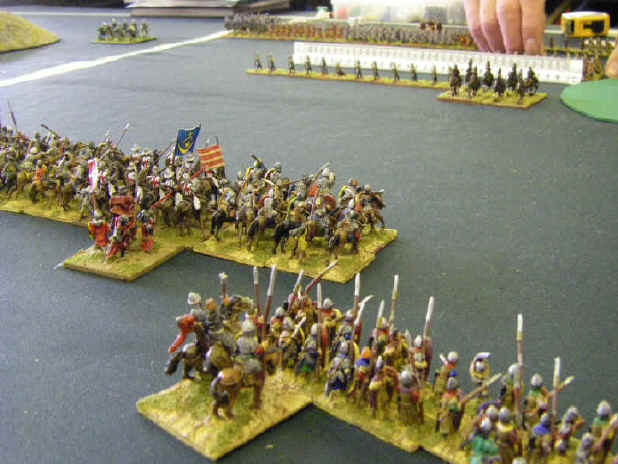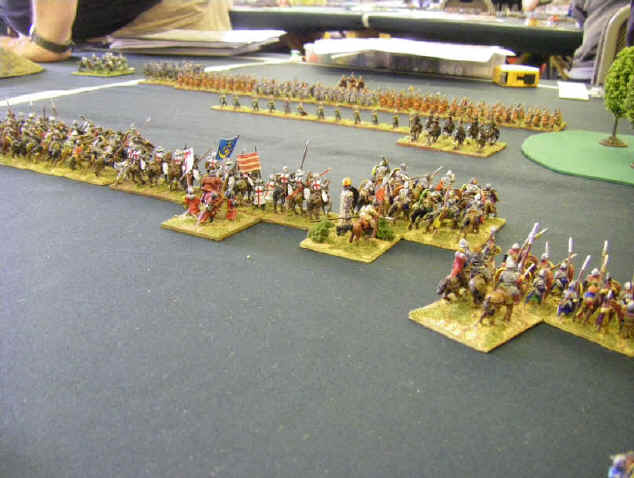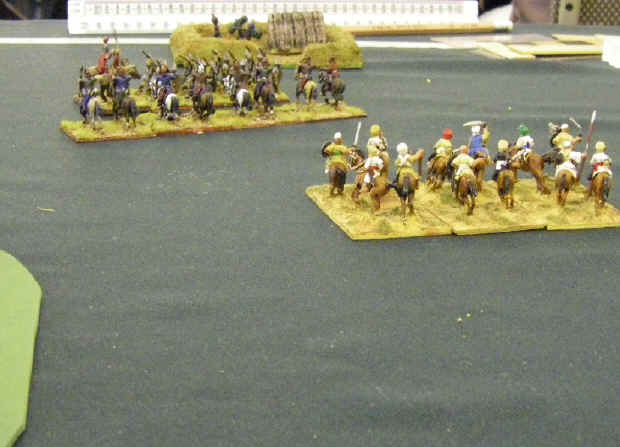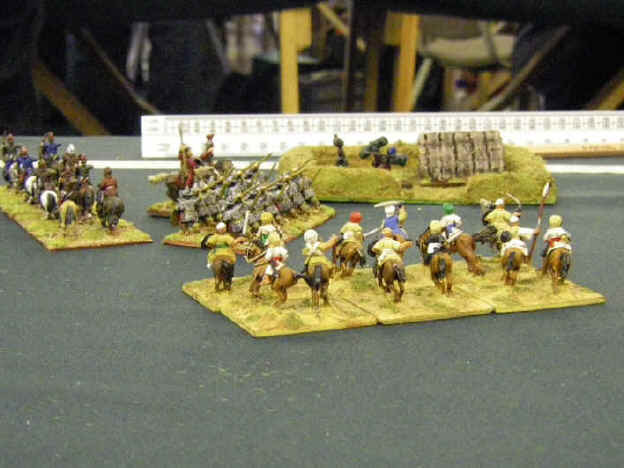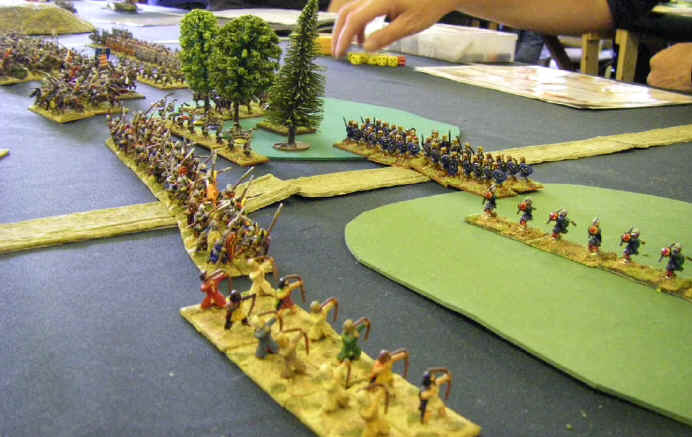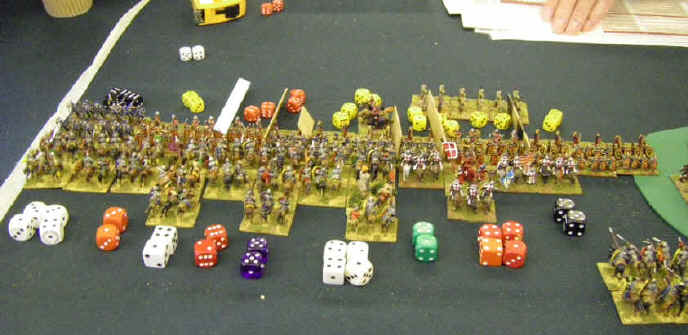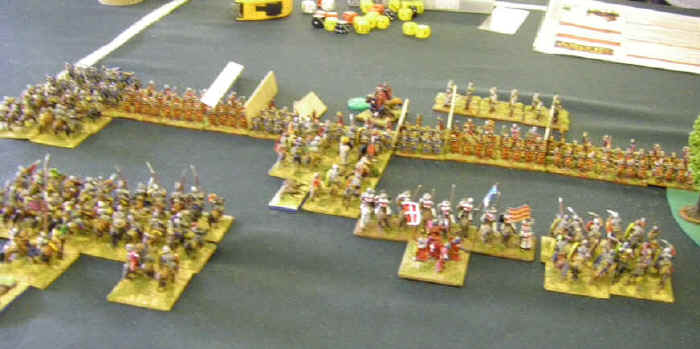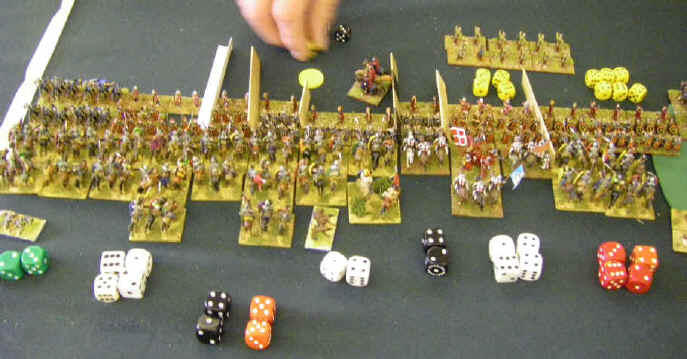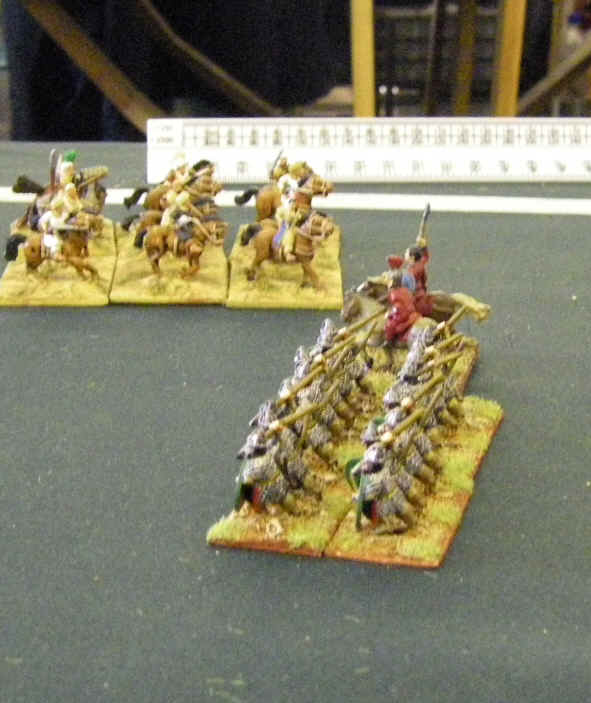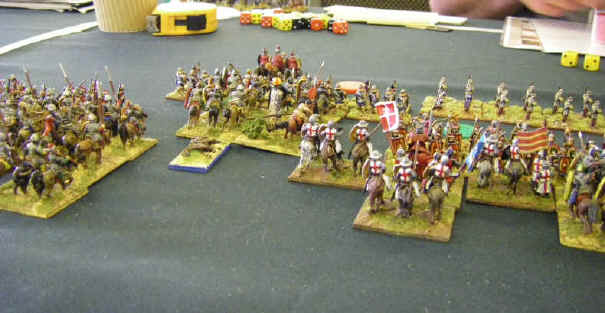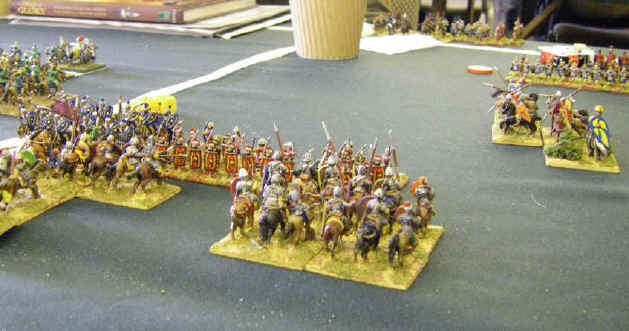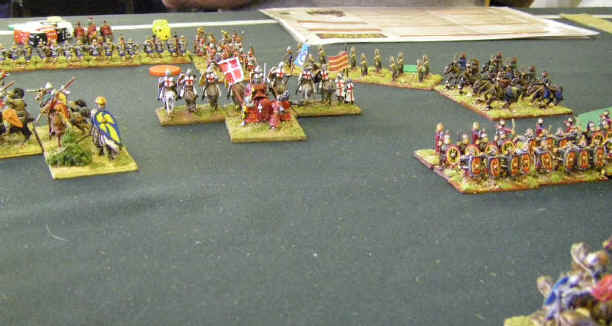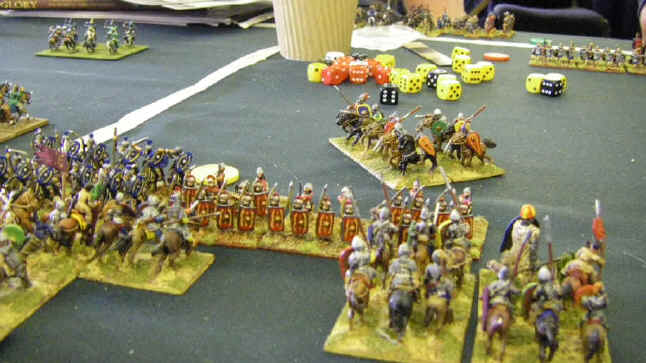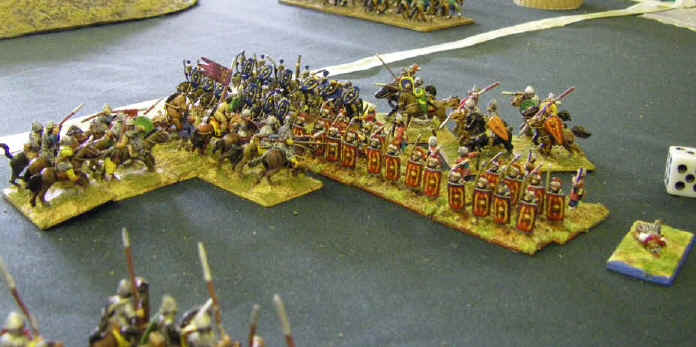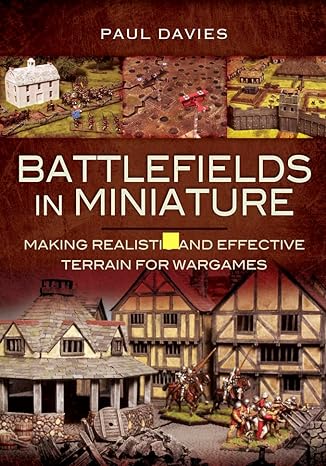Field of Glory Game 5 at Britcon 2008
Sunday Morning (a lifetime into the competition) saw me facing Late Romans (Principate in new money)
The game featured comedy terrain, with two circular woods right in the middle of the table, between which I put a road. We both deployed on the same half of the board.
Having worked out overnight that splitting my main strike troops was probably not a great idea, I had come up with a cunning plan. Bottle the likely auxilia up in the woods with my spearmen, and hit all the Romans in one go with all my cavalry in one big long line.
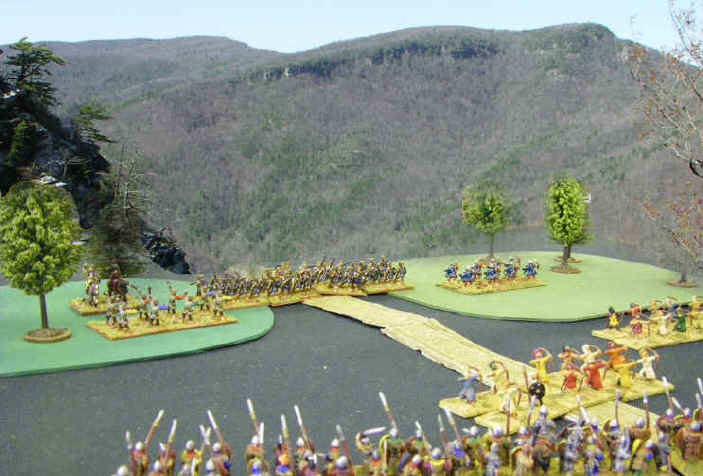
The bottling up bit was going well....
..and so was the "big long line" bit, as the Romans furiously flicked through their copies of Arrians Order of Battle Against The Alans and wondered what would happen !
With the benefit of a much simpler plan the battle progressed swiftly as I just piled forwards...
My Arab lancers had also - at last - found someone scared of them, in the shape of 4 Lh with bows
Pretty soon even the Roman delaying light troops were being squeezed out like the filling in a jam sandwich run over by a hippo in a Mini.
The Roman LH did not know what to do as the Arabs threatened to sack the camp, and even briefly considered a charge at the isolated auxilia
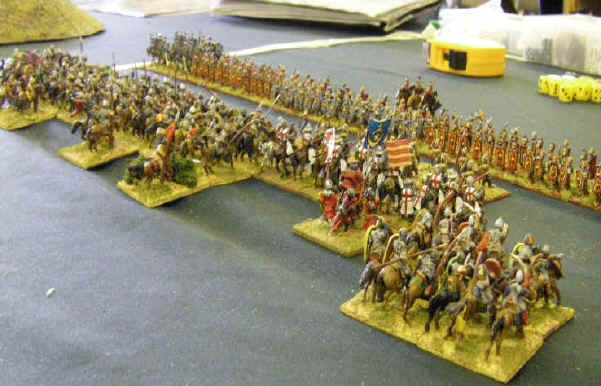
As Ant & Dec put it so pithily.... Lets Get Ready to Rumble!!
The advancing spears managed to flush out a few rubbish skirmishers hiding in the woods, who came forward to taunt the protected spearmen.
EVERYTHING charged in....there were more dice on the table than there are poppadoms at a Wargame clubs Christmas party (in fact so many we forgot the rear rank shooting dice...)
Nearly everything bounced off again - but the massive 8-strong average legion in the middle had gone disrupted - and my lancers had lost to the roman cavalry on the flank! Mounted break off unless more than half their opponents are non steady foot. This meant my 4-strong units bounced off the disrupted legion as they only had 1 base in contact with it, and 1 in contact with steady foot. Maybe I should have lined up square on to the legions?
EVERYTHING charged in again....(remembering the rear rank dice this time unfortunately..)
as this pattern carried on for some weeks, the arabs were quietly sacking the camp and chasing the mounted bowmen off table Evading off table is better than being caught - its only 1 attrition point, not 2. But I still wasn't prepared to try and take on the auxilia as my experience of LH vs y sort of decenttfoot had been universally bad
Eventually, something started to happen as the Average Roman legion proved to be The Weakest Link and said a brief Goodbye, before turning tail. Surely I could now exploit this gaping hole in the Roman line ....?
well, you would hope so, but it seemed that they turned so slowly and gave up pursuit so reluctantly that the battle would be over before they could rejoin the fray...
Even the knights, after breaking another unit, only pursued into relative danger rather than swinging into the flank they had just created!
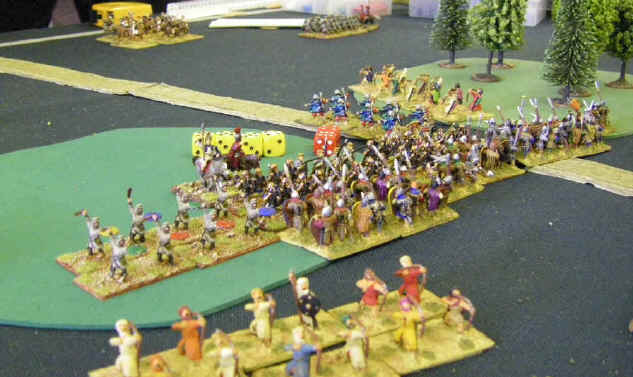
In the standoff center, my spearmen, sick of getting a pasting from the irritating slingers had charged - and rolled long, ending up in the wood from which they could not extract themselves! This had drawn in the auxilia, and in turn my armoured spearmen had advanced into the gap in the woods to take them on in the open. What had started as a low interest area of the table was getting rather fun-packed, as some Armenian bowmen were inspired to go hunting Roman bowmen behind the line of scrimmage...
The last remnants of Superior legionaries were proving incredibly resilient, and despite having a huge hole in the Roman lines, the boys in Red were able to escape from my slow moving flanking force simply by advancing as my cavalry bounced off them frontally.. I wouldn't last for ever, but it might last to the end of the game...
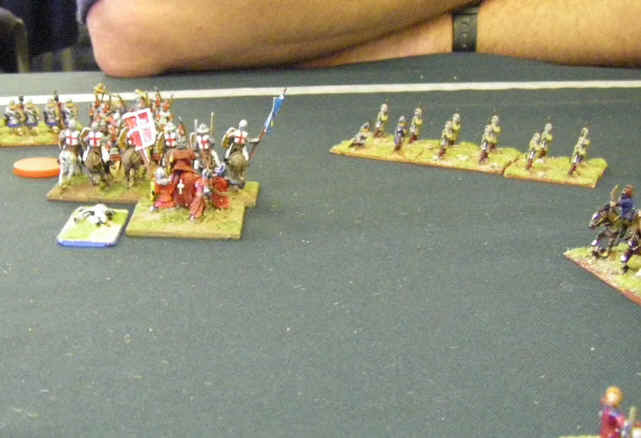
Meanwhile the Crusaders started to be swarmed by shooters, forcing them to keep pursuing the broken legions At least this meant the Romans could not rally any of their legions as I always remained within 6 inches
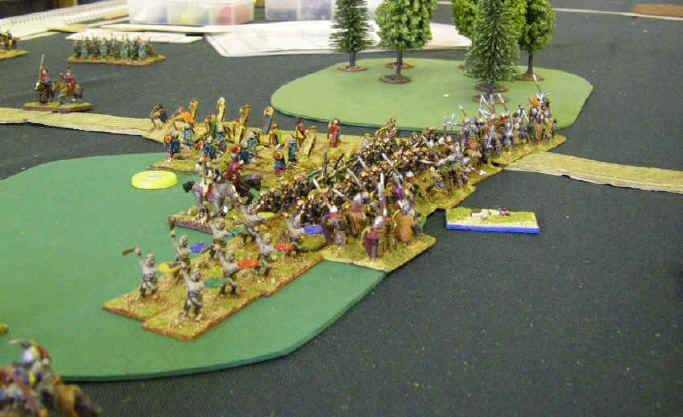
In the middle the auxiliaries were unable to make their superior rough terrain skills count, as my superior numbers ground them down - and my bowmen were jubilant at winning a combat as their opponents failed to evade far enough.. LF chasing each other in a wood is a bit scary - the possible +2/-2 on evade moves is a lot when compared to the actual move distance!
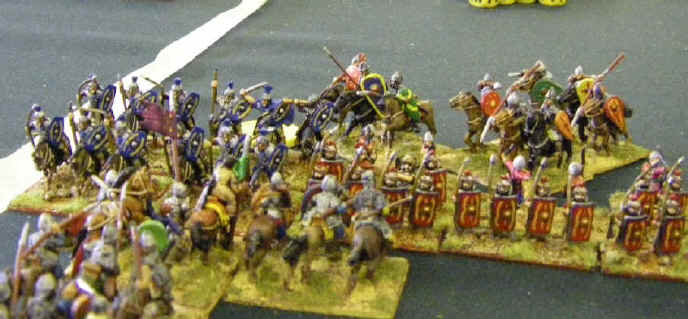
The charge crashed home into the rear of the beleaguered legion ...
Battered on both sides, this was the last straw for the unit, and indeed the army.... a complete victory for the Armenians!!
Post Match Analysis
This time I had actually concentrated my forces - although the Romans had done likewise - and repeated charges into a line of troops I was slightly better than had finally broken through the weakest section. Yet again it had seemed to take ages to exploit this advantage and ultimately it was the actions of my light bowmen and light horse in chasing and catching a couple of other light units that had managed to secure victory as otherwise I would have been able to beat all 5 legionary units without coming close to taking half the army.
Buy your own Romans on ebay
The Ancient Army List Index
The Rise of Rome (280 BC to 25 BC) Mid Republican Roman ; Late Republican Roman ; Gallic ; Pyrrhic ; Later Carthaginian ; Ancient Spanish ; Later Macedonian ; Later Seleucid ; Later Ptolemaic ; Attalid Pergamene ; Numidian or early Moorish ; Pontic ; Early Armenian ; Parthian ; Later Jewish ; Illyrian ; Spartacus Slave Revolt ; Bosporan ;
Storm of Arrows - Western Europe in the Later Middle Ages (1300 AD to 1500 AD) Medieval French ; 100-yrs War English (Continental) ; 100-yrs War English (Britain) ; Later Medieval Scots ( Britain) ; Later Medieval Scots (Continental) ; Later Scots Isles & Highlands ; Medieval Welsh ; Later Anglo-Irish ; Medieval Irish ; Low Countries ; Later Medieval German ; Italian Condotta ; Swiss ; Free Company ; Medieval Burgundian ; Medieval Danish ; Medieval Swedish ; Medieval Castilian ; Medieval Crown of Aragon ; Medieval Portugese ; Later Granadine ; Navarrese ; Ordonnance French ; Wars of the Roses English ; Ordonnance Burgundian ; Santa Hermandad Nueva Castilian
Immortal Fire - The Greek, Persian & Macedonian Wars (550 BC - 146 BC)
Classical Greek ;
Early Achaemenid Persian ;
Lydian ;
Thracian ;
Syracusan ;
Early Carthaginian ;
Skythian or Saka ;
Kyrenean Greek ;
Late Dynastic Egyptian ;
Alexandrian Macedonian ;
Later Achaemenid Persian ;
Classical Indian ;
Early Successor ;
Early Sarmatian ;
Galatian ;
Hellenistic Greek ;
Graeco-Bactrian ;
Graeco-Indian ;
Indo-Greek :
Legions Triumphant - Imperial Rome (25 BC to 493 AD) Dominate Roman ; Principate Roman ; Foederate Roman ; Later Sarmatian ; Early German ; Dacian or Carpi ; Ancient British ; Caledonian ; Early Alan ; Jewish Revolt ; Sassanid Persian ; Kushan or Indo-Skythian ; Palmyran ; Early Frankish, Alamanni, Burgundi, Limigantes, Rugian, Suevi or Turcilingi ; Western Hunnic ; Early Visigothic & Early Vandal ; Early Ostrogothic, Herul, Sciri or Taifali ; Early Anglo-Saxon, Bavarian, Frisian, Old Saxon or Thuringian ; Gepid or Early Lombard ; Early Scots Irish ; Early Pictish ; Hephthalite Hunnic ;
Swords & Scimitars - The Crusades (1096 AD to 1311 AD) Early Crusader ; Later Crusader ; Fatimid Egyptian ; Georgian ; Seljuk Turk ; Cuman ; Komnenan Byzantine ; Post Latin Conquest Byzantine ; Ilkhanid Mongol ; Mamluk Egyptian ; Cilician Armenian ; Syrian States ; Khwarazmian ; Ayyubid Egyptian ; Middle Serbian ; Middle Bulgarian ; Medieval Cypriot ; Latin Greece ; Pecheneg ;
Eternal Empire - Eastern Europe and the Rise of the Ottomans (1300 AD to 1500 AD) Early Ottoman Turkish ; Later Ottoman Turkish ; Tatar ; Later Russian ; Later Serbian Empire ; Later Bulgarian ; Later Lithuanian ; Later Polish ; Later Teutonic Knights ; Catalan Company ; Middle Hungarian ; Moldavian or Wallachian ; Albanian ; Timurid, White Sheep Turcoman or Black Sheep Turcoman ; Later Hungarian ; Hussite ;
Decline & Fall - Byzantium and Islam (493 AD to 1071 AD) Early Byzantine; Maurikian Byzantine ; Thematic Byzantine ; Nikephorian Byzantine ; Later Moorish ; Later Visigothic ; African Vandal ; Italian Ostrogothic ; Early South Slav ; Lombard ; Avar ; Arab Conquest ; Early Bulgar ; Ummayad Arab ; Abbasid Arab ; Early North African Dynasties ; Khurasanian Dynasties ; Bedouin Dynasties ; Dailami Dynasties ; Pecheneg ; Ghaznavid ; Western Turkish (includes Khazar);
Wolves From The Sea - The Hairy European Dark Ages Post Roman British ; Early Welsh ; Later Scots Irish ; Merovingian Frankish ; Later Pictish ; Early Slavic ; Middle Anglo Saxon ; Astur Leonese ; Andalusian ; Early Navarrese ; Carolingian Frankish ; Viking ; Magyar ; Great Moravian ; Early Scots ; Rus ; Norse Irish ; Early Medieval French ; Early Medieval German ; Norman ; Early Polish ; Anglo Danish ;
Swifter Than Eagles - The Biblical Book Nubian ; Early Libyan ; Later Sumerian or Akkadian ; Early Nomad Allies ; Old or Middle Kingdom Egyptian ; Hyksos ; Mitanni ; Syro-Canaanite ; New Kingdom Egyptian ; Later Minoan or Early Mycenaean ; Hittite Empire ; ; Middle or Early Neo-Assyrian ; Later Mycenaean or Trojan ; Sea Peoples ; Philistine ; Phoenician Allies ; Neo-Hittite And Aramaean ; Later Hebrew ; Mannaean Allies ; Libyan Egyptian ; Urartian ; Median ; Neo-Elamite ; Proto-Arab Allies ; Cimmerian or Early Skythian ; Neo-Assyrian Empire ; Phrygian Allies ; Kushite Egyptian ; Neo-Babylonian Empire ;
Oaf of Fealty - Early Medieval Europe Feudal Catalan and Early Crown Of Aragon ; Early Hungarian ; Taifa Andalusian ; Feudal Navarrese and Aragonese ; Feudal Castilian Leonese or Portuguese ; Fanatic Berber ; Italo-Norman ; Feudal French ; Imperial German ; Feudal German ; Communal Italian ; Papal Italian ; Early Scots Isles And Highlands ; Feudal Scots ; Early Russian ; Feudal Polish ; Anglo-Norman ; Later Welsh ; Early Lithuanian or Samogitian ; Wendish Prussian or Estonian ; Early Medieval Frisia and Other Free Cantons ; Post-Viking Scandinavian ; Early Plantagenet English ; Later Sicilian ; Early Medieval Irish ; Early Anglo-Irish ; Early Teutonic Knights ; Mongol Invasion ; Early Granadine ; Middle Plantagenet English ;
Empires of The Dragon - China, Korea and Japan Erlitou-Shang Chinese ; Early Northern Barbarian Allies ; Early Zhou Chinese ; Yayoi Japanese ; Early Horse Nomad ; Ko Choson Korean ; Warring States To Western Han Chinese ; Qiang And Di ; Three Kingdoms Korean ; Eastern Han Chinese? ; Three Kingdoms W Jin And S Dynasties Chinese ; Kofun Nara Japanese ; Northern Dynasties Chinese ; Later Hindu North Indian ; Later Hindu South Indian ; Central Asian City States ; Western Wei To Early Tang Chinese ; ; Later Horse Nomad ; Tibetan ; Nepalese Allies ; Parhae Korean ; Late Tang To Five Dynasties Chinese ; Khmer Or Champa ; Thai Allies ; Nanzhao ; Pyu Burmese Allies ; Koryo Korean ; Early Heian Japanese ; Pagan Burmese ; Liao ; Song Chinese ; Xi Xia ; Ghurid Afghan ; Jin ; Late Heian To Muromachi Japanese ; Japanese Warrior Monk Allies ; Mongol Conquest ; Moslem Indian Sultanates ; Medieval Indonesian Or Malay ; Yuan Chinese ; Medieval Burmese ; Ming Chinese ; Yi Korean
Blood and Gold - The Americas Olmec ; Teotihuacan ; West Mexican ; Zapotec or Mixtec ; Toltec ; Chinantec ; Aztec ; Tarascan ; Tlaxcalan Confederacy ; Mayan ; Mochica ; Chanca ; Chimu ; Hatun-Colla ; Canari ; Inca ; Mapuche or Araucanian ; Amazonian Forest Tribes ; Tupi ; Chichimec ; Pueblo Culture ; Mound-Builder Culture ; South-Eastern Woodland Culture ; Timucuan ; Eastern Woodland Culture ; Plains Culture ; Pacific North-West Culture



